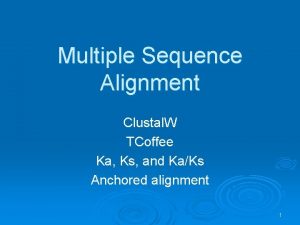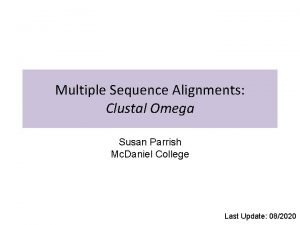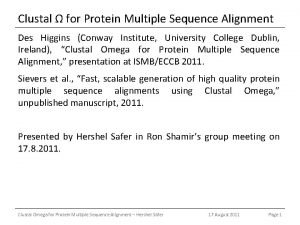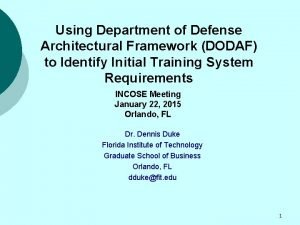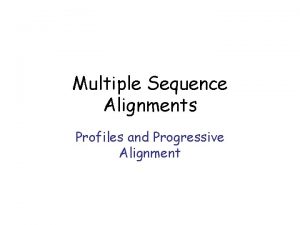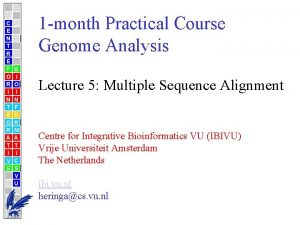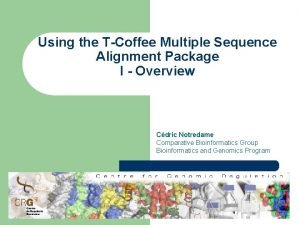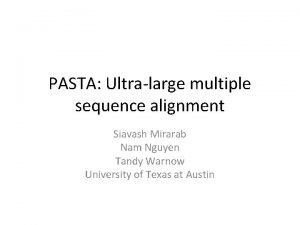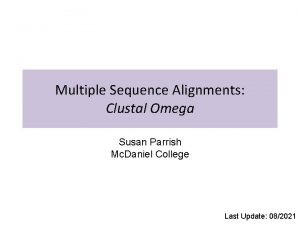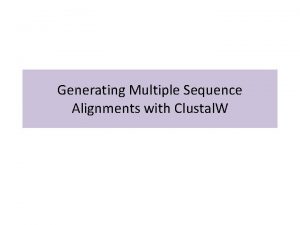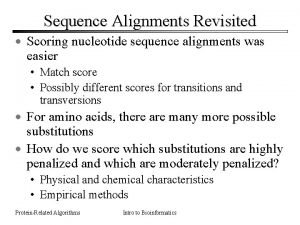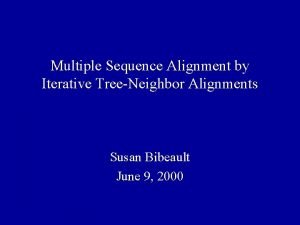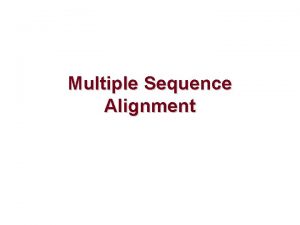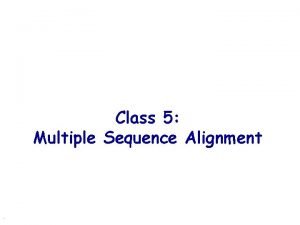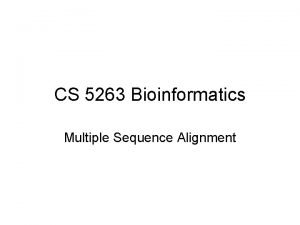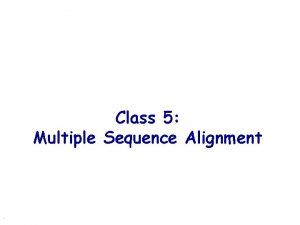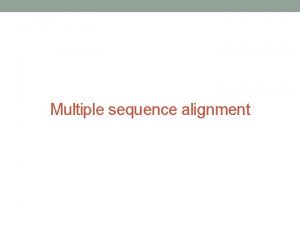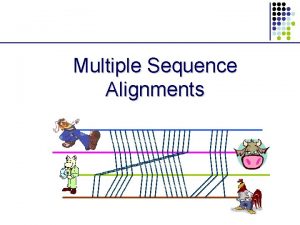Multiple Sequence Alignments Clustal Omega Susan Parrish Mc

































- Slides: 33

Multiple Sequence Alignments: Clustal Omega Susan Parrish Mc. Daniel College Last Update: 08/2020

BLAST • What does basic BLAST do (e. g. what is input sequence and how does BLAST look for matches? )

Multiple Sequence Alignments & Building Phylogenetic Trees • Basic BLAST: input query and search database for homologous sequences and see pair-wise matches (query/subject) • However, what if you want to specify the sequences to align? 1) Two sequences: NCBI BLAST — (bl 2 seq) 2) Three or more sequences: Clustal Omega 3) Building trees from multiple sequence alignments: Clustal Simple Phylogeny

Clustal: Creating a Multiple Sequence Alignment • You SELECT sequences to align to identified conserved nucleotides or amino acids • What conserved sequences might you identify in a multiple sequence alignment of DNA sequences? • What conserved sequences might you identify in a multiple sequence alignment of amino acid sequences? • How could you use multiple sequence alignments to build phylogenetic trees?

Consensus Nucleotide Sequences • A consensus nucleotide sequence is derived by making a multiple sequence alignment and calculating the most represented nucleotide at each position • Provides insight into the functional regions of a given sequence (more important for function = conservation through evolution) • Example: If a DNA binding site is necessary to recruit a specific protein, expect that DNA sequence to be conserved during evolution

Consensus Nucleotide Sequences: Promoters • Determine consensus sequence found in promoter for RNA polymerase recruitment by multiple sequence alignments of regions upstream of genes • Closer a promoter is to consensus sequence, stronger the promoter in driving expression of gene (better at recruiting RNA polymerase) • Individual promoters usually differ from the consensus at one or more positions

Prokaryotic -10 & -35 Promoter Consensus Sequence • The prokaryotic promoter consensus sequence • Closer to this sequence, more easily recognized by prokaryotic RNA polymerase Sense

Prokaryotic -10 & -35 Promoter Consensus Sequence

A Eukaryotic Consensus Sequence Deep Thoughts: Any idea what this consensus sequence controls?

Proteins: Conserved Domains • Can find conserved domains in proteins by performing multiple sequence alignments of amino acid sequences • If a region of a protein has a particular function that is important (e. g. DNA binding domain/ protein-protein interaction domain/ enzymatic active site) will see conservation of amino acids within that domain • Conserved domains tend to fold independently of other parts of protein (therefore structure of domain conserved) • Appears that conserved domains have been “shuffled” during evolution to create new proteins

Proteins: Conserved Domains

Many Proteins have Multiple Conserved Domains

Clustal Omega: Creating a Multiple Sequence Alignment • Select sequences to align from NCBI • Google “Clustal Omega” • Click on the link for the EMBL-EBI Clustal Omega page: • https: //www. ebi. ac. uk/Tools/msa/clustalo/ • Get FASTA sequences and copy and paste into Clustal Omega window

Clustal Omega: Creating a Multiple Sequence Alignment

Clustal Omega: Creating the Initial Alignment

Generating the Sequence Files Get FASTA file for sequence 1 Copy and paste into Clustal Omega input window Hit return Get FASTA file for next sequence Copy and paste it below first sequence in Clustal Omega input window • Hit return • Keep repeating until get all files in window • • •

Generating the Sequence Files • As you do this, prudent to record accession numbers in case of malfunction (can also keep each sequence open in separate tab)

Clustal Omega: The Alignment Report

Clustal Omega: The Alignment Report • Consensus symbols for protein alignments Symbol Description * Position with a fully conserved residue : Conservation between groups of strongly similar properties . Conservation between groups of weakly similar properties Position with residues that have different properties • Consensus symbols for nucleotide alignments Symbol * Description Position with fully conserved nucleotide Position with different nucleotides Ignore the “: ” and “. ” consensus symbols for nucleotide alignments

Clustal Omega: The Alignment Report


Clustal Omega: The Alignment Report

Simple Phylogeny: Making a Phylogenetic Tree • Simple Phylogeny can only assemble a phylogenetic tree from multiple sequence alignments generated by Clustal Omega

Simple Phylogeny: Making a Phylogenetic Tree

Simple Phylogeny: Making a Phylogenetic Tree CHANGE to “on”!

Simple Phylogeny: Making a Phylogenetic Tree

Simple Phylogeny: Making a Phylogenetic Tree

PHYLIP: Phylogeny Inference Package

Simple Phylogeny: Making a Phylogenetic Tree

Neighbor Joining

Neighbor Joining Yang Z and Rannala B. Nat Rev Genet. 2012 Mar 28; 13(5): 303 -14.

• A Cladogram is a branching diagram (tree) assumed to be an estimate of a phylogeny where the branches are of equal length, thus cladograms show common ancestry, but do not indicate the amount of evolutionary "time" separating taxa.

Simple Phylogeny: Making a Phylogenetic Tree Distance Value= # of substitutions as a proportion of the alignment, excluding gaps
 Tcoffee multiple sequence alignment
Tcoffee multiple sequence alignment Clustal w omega
Clustal w omega Clustal omega reference
Clustal omega reference Dodaf views
Dodaf views Esansiyel aminoasitler
Esansiyel aminoasitler Omega 6
Omega 6 Liz parrish
Liz parrish Allineamento multiplo
Allineamento multiplo Clustal w slideshare
Clustal w slideshare Multiple baseline vs multiple probe design
Multiple baseline vs multiple probe design Example of mimd
Example of mimd Time sequence of multiple interrupts
Time sequence of multiple interrupts A named sequence of statements
A named sequence of statements Kkllkk profile
Kkllkk profile Praline multiple sequence alignment
Praline multiple sequence alignment T coffee multiple sequence alignment
T coffee multiple sequence alignment Pasta alignment
Pasta alignment Repetition pseudocode example
Repetition pseudocode example 1^5+2^5+3^5+...+n^5 formula
1^5+2^5+3^5+...+n^5 formula Convolutional sequence to sequence learning.
Convolutional sequence to sequence learning. Amino acid nucleotide
Amino acid nucleotide Omega vragenlijst
Omega vragenlijst Weather.gov
Weather.gov Effect size small medium large
Effect size small medium large Asymptotic notation exercises
Asymptotic notation exercises Alfabet matematika
Alfabet matematika Alpha kappa alpha hymn and pledge
Alpha kappa alpha hymn and pledge Rond point benjamin franklin montpellier
Rond point benjamin franklin montpellier Big o notation rules
Big o notation rules Omega plumbing
Omega plumbing Roux loop conversion
Roux loop conversion Alpha kappa alpha graduate chapter letter of invitation
Alpha kappa alpha graduate chapter letter of invitation Omega plus max
Omega plus max Alpha omega alpha osteopathic
Alpha omega alpha osteopathic
